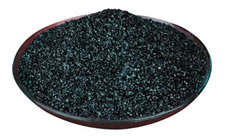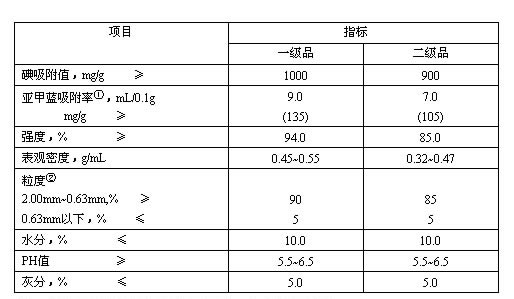The wood powdered activated carbon is made of high-quality wood chips and is produced by the zinc chloride method. It has a developed mesoporous structure, large adsorption capacity and fast filtration. It is mainly used in various amino acid industries, such as decolorization, purification, deodorization and impurity removal of high pigment solutions such as refined sugar decolorization, monosodium glutamate industry, glucose industry, starch sugar industry, chemical additives, dye intermediates, food additives and pharmaceutical preparations.
Powdered activated carbon is made of high-quality charcoal as raw material and refined by special production process. There are two kinds of physical methods and chemical methods. After being activated by steam, it is refined and pulverized. This product has a black powder appearance and does not dissolve under normal solutions. It is odorless and tasteless, with large surface area, strong adsorption, high purity, fast filtration speed, stable quality, flocculation effect and filter aid effect. It is widely used in the decolorization and impurity removal of food, medicine, MSG and other products. It can also be used for the purification of water.

Wooden powdered activated carbon
The wood powdered activated carbon produced by the phosphoric acid method has a developed mesoporous structure and a developed specific surface area, and has large adsorption capacity, high filtration speed, and no zinc salt. It is widely used in the food industry for the decolorization and refining of sugars, glutamic acid and salt, lactic acid and salt, citric acid and salt, wine, condiments, animal and plant proteins, biochemical products, pharmaceutical intermediates, vitamins, antibiotics, etc. Deodorize and remove impurities.
The injection charcoal produced by our factory has less impurities, high purity, fast filtration speed, excellent decolorization, purification and purification, etc. It is mainly used for decolorization, refining and removal of "heat source" of various injection chemicals. It can also be decolorized with vitamin C and other APIs, with strong decolorization power and fast filtration speed. It is suitable for decolorization and refining of medicines, pesticides and Chinese and Western medicines. It has the function of absorbing intestinal bacteria and detoxification.
1. Chemical powdered activated carbon:
Appearance: It is black powder, odorless, tasteless, and does not dissolve in general solvents.
Performance: high quality wood chips and husks are used as raw materials, zinc chloride and phosphoric acid are activators. They are carbonized and activated and refined. The finished product has excellent adsorption capacity and low impurity content.
Uses: It is suitable for the purification of decolorized phase of sugars such as glucose sucrose and maltose, as well as the removal, purification and purification of macromolecular pigments in citric acid, cystine, oil and chemical products.
2, physical method powdered activated carbon:
Properties: It is made of high-quality nut shell and wood chips. After steam activation, it is refined and pulverized. The appearance is black fine powder, non-toxic, odorless, with large specific surface area and strong adsorption capacity.
Uses: This product is suitable for decolorization, impurity removal and exquisiteness of medicines, food additives, monosodium glutamate, chemicals, beverages, etc. It is suitable for water purification treatment.
Technical indicators related to powdered activated carbon:

Activated carbon is a porous carbonaceous material. It has a highly developed pore structure and is an excellent adsorbent. The adsorption area per gram of activated carbon is equivalent to that of eight tennis balls. The adsorption is borrowed. It is achieved by physical adsorption force and chemical adsorption force. Its constituent materials contain a small amount of hydrogen, nitrogen, oxygen and ash in addition to carbon, and its structure is formed by carbon-forming hexacyclic materials. Due to the irregular arrangement of the six-ring carbon, the characteristics of the microporous volume and high surface area of ​​the activated carbon are caused.
Activated carbon can be made from a variety of carbonaceous materials including wood, sawdust, coal, coke, peat, lignin, pits, hard husks, sucrose pulp, bone, lignite, petroleum residues, and the like. Among them, coal and coconut shell have become the most commonly used raw materials for the manufacture of activated carbon. The manufacture of activated carbon is basically divided into two processes. The first process includes dehydration and carbonization, heating the raw materials, drying at a temperature of 170 to 600 ° C, and carbonizing the original organic matter by about 80%. The second process is to activate the char, which is carried out by reacting an activator such as steam with carbon. In the endothermic reaction, a mixed gas consisting of CO and H2 is mainly produced for burning the heated char to a suitable temperature (800). Up to 1000 ° C), in order to burn off all the decomposable substances, thereby producing a developed microporous structure and a large specific surface area, and thus has a strong adsorption capacity.
The pores of activated carbon can be classified into three types according to the size of the pore size. Large hole: Radius 1000 - 1000000 A. Transition hole: radius 20 - 1000 A. Micropores: Radius - 20 A.
Activated carbon made from different raw materials has pore sizes of different sizes. Coconut shell activated carbon has the smallest pore radius. Wood activated carbons generally have the largest pore radii, they are used to adsorb larger molecules and are used almost exclusively in the liquid phase. The first type of granular activated carbon used in the field of urban water treatment is made of wood, called charcoal. The pore size of coal-based activated carbon is somewhere in between.
In coal-based activated carbon, lignite activated carbon has more transition pores and larger average pore diameter than anthracite activated carbon, so it can effectively remove macromolecular organic matter in water.
Activated carbon, which is generally used in water treatment, has a surface area that is not necessarily too large, but should have more transition pores and a larger average pore diameter. Some activated carbons for liquid phase sales in Japan have the following characteristics: a specific surface area of ​​850 to 1000 m 2 /g, a pore volume of 0.88 to 1.5 ml/g, and an average pore radius of 40 to 50 A.
Introduction to activated carbon function:
Activated carbon has high-efficiency air purification function, activated carbon can create a comfortable and clean environment, activated carbon is more protective to human health, activated carbon is an invisible air filter, activated carbon is a combination of physical adsorption and chemical decomposition, and decomposes formaldehyde in the air. , ammonia, benzene, cigarettes, oil smoke and other harmful gases and various odors, especially carcinogenic aromatic substances, activated carbon has a strong adsorption capacity, is a commonly used adsorbent, catalyst or catalyst carrier, easy to air The harmful gas is in full contact, and the activated carbon uses its own pore adsorption to suck harmful gas molecules into the pores, blowing out fresh and clean air. Therefore, family partners cannot do without activated carbon.
Application of activated carbon:
Activated carbon is widely used in various aspects of industrial and agricultural production, such as alkali-free deodorization (refined desulfurization), ethylene demineralized water (refined filler), catalyst carrier (palladium, platinum, rhodium, etc.), water purification and sewage treatment in the petrochemical industry; Water treatment and protection of power plants in the industry; chemical catalysts and carriers in the chemical industry, gas purification, solvent recovery and decolorization and refining of oils and fats; refining and decolorization of beverages, alcohols, MSG and foods in the food industry; gold in the gold industry Extraction, tail liquid recovery; environmental treatment industry sewage treatment, waste gas and harmful gas treatment, gas purification; and related industries, cigarette filters, wood floor moisture, odor absorption, automotive gasoline evaporation pollution control, preparation of various impregnating liquids Wait. Activated carbon will have excellent development prospects and a broad sales market in the future.
Graphite Plate for Vacuum Pumps,Carbon Vanes for Vacuum Pump,Vacuum Pump Carbon Sheet
Dongguan Beqile Mechanical&Electrical Equipment CO.,LTD , https://www.betemvacuum.com